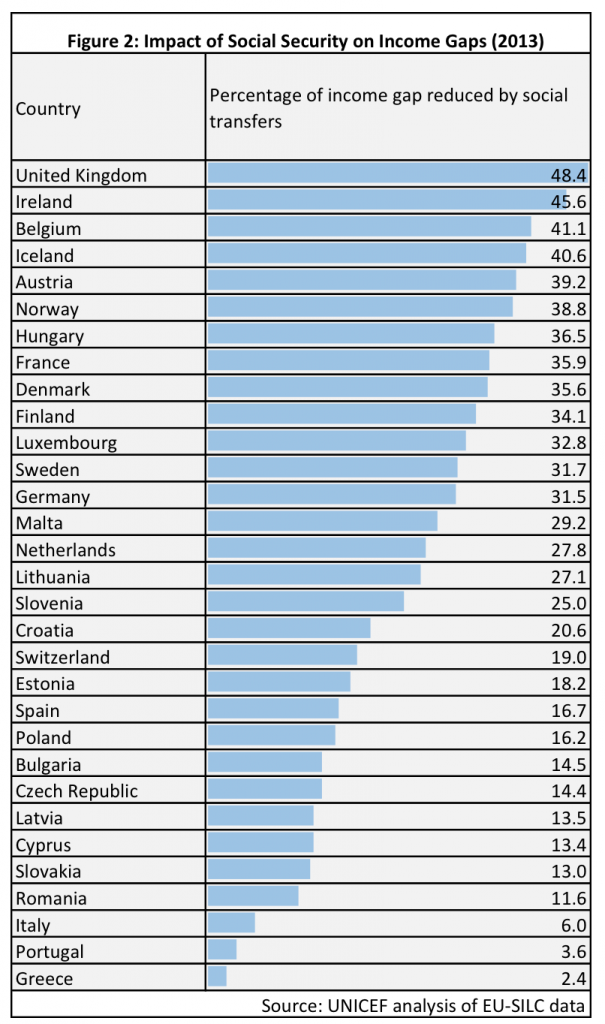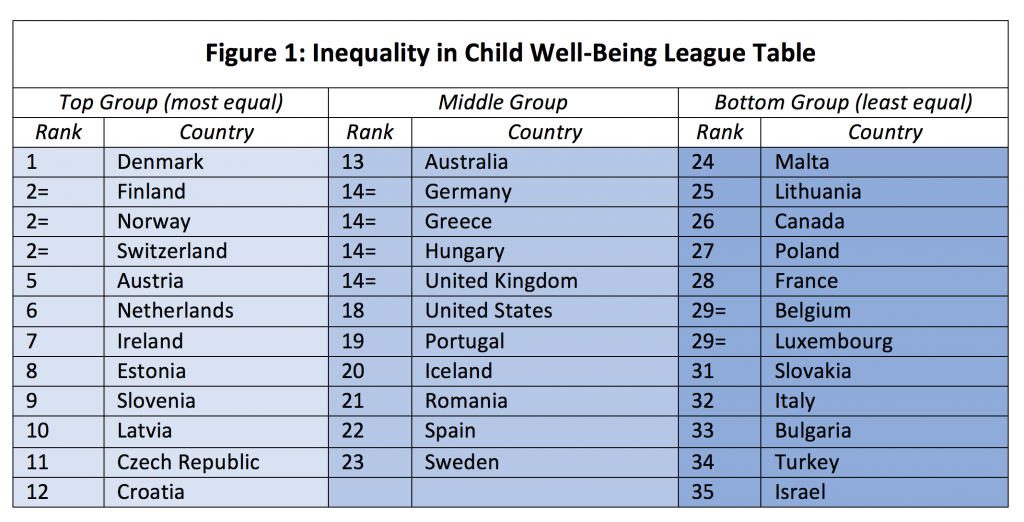More must be done to give the UK’s most vulnerable children a fairer start in life
UNICEF’s long-running Report Card series provides a regular assessment of how rich countries fare in promoting child well-being. The latest Report Card, Fairness for Children, assesses ‘child well-being gaps’, which measure the distance between the most disadvantaged children and the ‘average’ child in each country. While much of the debate about inequality today focuses on the top 1 per cent, these measures capture the extent to which the most disadvantaged children fall behind the levels of well-being their peers can expect. This focus on so-called ‘bottom-end inequality’ therefore captures the extent to which each country allows their most vulnerable children to fall behind.
The Report Card examines four domains of child well-being – income, education, health, and life satisfaction – and the UK’s performance can be summed up as ‘could do better’. Overall, the UK is ranked 14th (from best) out of 35 countries (Figure 1). It ranks mid-table in three of the four child well-being domains: 25th out of 37 countries on educational achievement gaps; 19th out of 35 countries on health gaps; 20th out of 35 countries on life satisfaction gaps. The UK, in common with many other countries, has made little progress in reducing gaps in these child well-being domains since the 2000s.
The UK does rather better in terms of protecting the incomes of the most disadvantaged children, ranking 7th out of 41 countries. But while the gap has narrowed significantly since 2008, this is because the incomes of children at the middle of the income distribution have fallen rather than as a result of a dramatic improvement in the incomes of children at the bottom of the distribution. Hardly, in other words, a good news story.
That said, there is a good news story here: the incomes of the UK’s poorest children did not dramatically fall following the recession. Clear contrasts can be drawn here with many other countries hit hard by the economic crisis, particularly those in Southern Europe. This reflects the comparatively strong role social security benefits have played in protecting the incomes of many families with children in the UK. Indeed, across Europe no other country’s social security system does more in reducing the gap between the incomes of the poorest children and the average child (Figure 2).
However, social security protections for working age people have been the major focal point of the UK’s austerity agenda. Ongoing cuts to social security provision are likely to affect the well-being of the poorest children in the UK in future years, and risk widening inequalities in child well-being still further. Indeed, theResolution Foundation and the Child Poverty Action Group have warned that low income working families face losing relatively large amounts of income because of recent changes to Universal Credit that are about to take effect.
 Moreover, the UK’s social security system has to work harder than those of most neighbours because underlying levels of inequality are comparatively high. While the government’s ‘National Living Wage’ is a step in the right direction here, the Institute for Fiscal Studies (IFS) suggest it will have little impact on poverty or inequality. In fact, after modelling the cumulative impact of recent changes to tax, benefit and labour market policies, the IFS is projecting a rise in relative child poverty from 17 per cent in 2014-15 to 25.7 per cent in 2020-21 and a rise in absolute child poverty from 16.7 to 18.3 per cent over the same period.
Moreover, the UK’s social security system has to work harder than those of most neighbours because underlying levels of inequality are comparatively high. While the government’s ‘National Living Wage’ is a step in the right direction here, the Institute for Fiscal Studies (IFS) suggest it will have little impact on poverty or inequality. In fact, after modelling the cumulative impact of recent changes to tax, benefit and labour market policies, the IFS is projecting a rise in relative child poverty from 17 per cent in 2014-15 to 25.7 per cent in 2020-21 and a rise in absolute child poverty from 16.7 to 18.3 per cent over the same period.
The analysis presented in the UNICEF Report Card suggests the government may struggle to improve child well-being outcomes without addressing rising income differentials. Countries that protect the incomes of the poorest children most strongly tend to have higher levels of overall child well-being. More generally, countries with more equal income distributions also tend to be those that do better in minimising adverse child well-being outcomes.
Newly released data from the latest (2014) wave of the Health Behaviours in School-Aged Children (HBSC) survey included in the Report Card shows that, across rich countries, children living in less affluent households are more likely to be unsatisfied with their lives than their peers. This confirms patterns found in the 2002, 2006 and 2010 HBSC data. It is hard to imagine a more powerful argument for addressing social inequalities among children than the fact that across all rich countries, and on every occasion this century they have been asked, children from economically disadvantaged households are consistently more likely to have told HBSC researchers that they are unsatisfied with their lives.
Child well-being gaps are a concern in their own right, but a further reason for policy makers to prioritise reducing them is that smaller gaps tend to benefit all children. Fairness for Children shows that countries with more equal child well-being outcomes tend to also have: fewer children living in poverty; fewer children lacking basic educational skills in reading, maths and science; fewer children reporting ill-health on daily basis; and, fewer children reporting very low levels life satisfaction.
UNICEF ’s report cards suggest the UK has made progress in addressing overall levels of child well-being since being ranked bottom of the table in the early 2000s. Stephen Crabb used his first speech as Secretary of State for Work and Pensions to pledge ‘a relentless focus on improving life chances’ by mobilising ‘all parts of government to tackle poverty’ and creating ‘a welfare system that does protect the most vulnerable’. If the government is serious about this agenda then it must to do more to close child well-being gaps and give the UK’s most vulnerable children a fairer start in life.
This article by John Hudson and Stefan Kühner, was first published on the British Politics and Policyblog


